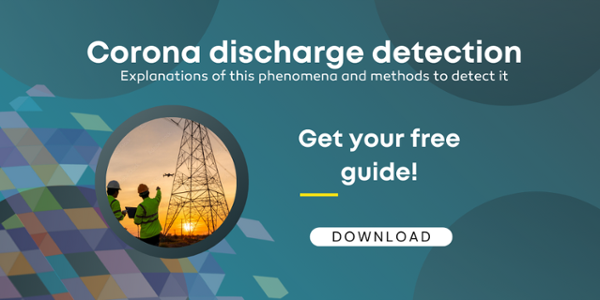Maintenance of high voltage power lines with a length of more than 10 km, is of major importance for electricity infrastructure companies. In Europe, electricity networks are mainly aerial and not subterranean. Two European countries (Denmark and the Netherlands) have chosen to put certain sections of their power line network underground for landscape improvement. Investment costs for underground lines are much higher than for aerial, thought maintenance cost are ten times less.
With more than 300 000 km of aerial high voltage power lines, European electricity infrastructure companies must implement efficient inspection processes to ensure 24/7 power grid reliability. Outside of Europe, in the Americas or Asia, transmission network largely consists of high-voltage cables with towers to support them beteween long distances. Brazil and China have built power line in the 2000 km range.
The right technologies to detect Corona discharges
Ultra-Violet cameras (UV) and thermal cameras inspection have been selected as the most appropriate ways to detect defaults in an early stage. They could be used in combination to take benefit of the two spectral band to identify more defaults and enlarge the diagnosis capacity.
UV cameras operate in the range of 200 to 400 nm. In this range, to avoid sun radiation perturbation, the solar blind UV camera operates between 240 to 280 nm. These cameras are suitable to detect Corona discharges which emit in this region, during daytime conditions. Since corona discharges produce low signal, it’s important to have high sensitivity and capabilities to change integration time.
Thermal cameras operate in the range of 8 to 10 µm. This equipment detects the temperature variation of each element of a scene. People with higher temperature (around 37°C) are brighter than the background which is colder. Infrared imaging is able to identify heat elevation and could also be used either in day or night conditions. In the case of power line inspection, thermal systems are used to detect overheated elements, which could be damaged insulators or potential short-circuits.
UltraViolet camera and Thermal camera combination for predictive maintenance in electric lines
The combination of both UV and thermal camera, in addition to a visible one, is the best candidate to perform predictive maintenance. A wide range of defaults can be observed, related, for example, to insulators and solder joints. These systems are typically developed with a friendly user interface to be easily handled by operators. Image processing is one of the big stakes in order to take benefit of the image quality of each sensor. UV cameras generally use intensified cameras, which is a coupling of UV image intensifier and a CMOS camera while thermal cameras use uncooled microbolometer technology.
These two technologies provide the best sensitivity and contrast required for such kind of application. In addition, technology improvements have allowed for integration into small forms, becoming SWaP (Size Weight and Power), which have opened the door for aerial integration in UAV or helicopters. Photonis product offers provide cameras that utilize both Smart Tube Management and state-of-the-art electronic, to REVEAL THE INVISIBLE!






